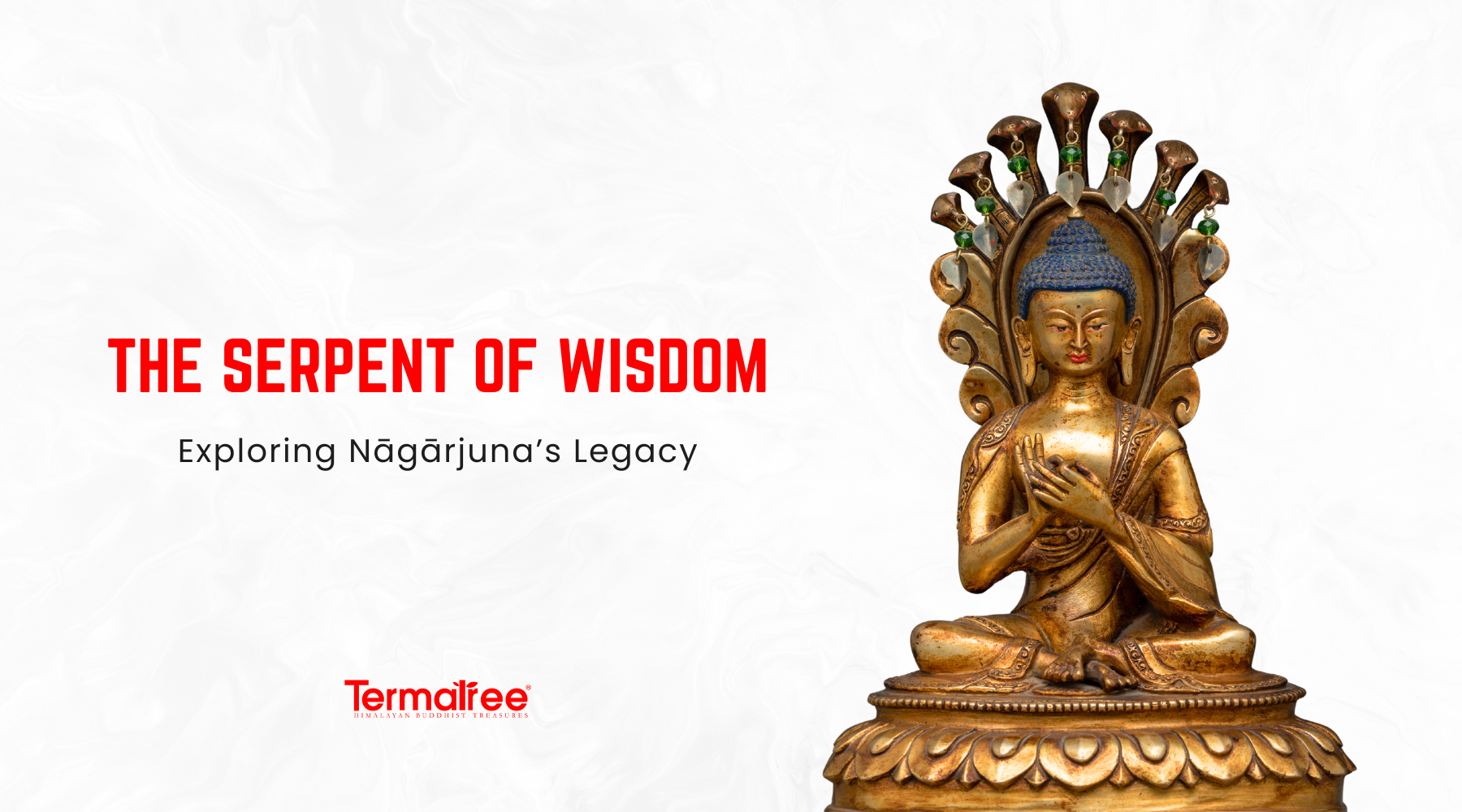Unraveling the Philosophical Depths of the Great Madhyamaka Master
Nāgārjuna, a great Buddhist philosopher, is called the "Serpent of Wisdom" for his intellect and transformative teachings. He is widely acknowledged as the founder of the Madhyamaka school of philosophy, commonly referred to as the "Middle Way," and his most renowned work, the Mūlamadhyamakakārikā, makes a crucial philosophical contribution by scrutinizing the nature of reality through a focus on śūnyatā, or emptiness, and pratītyasamutpāda. This concept asserts that all entities arise dependently on their causes and conditions, which means they lack intrinsic, independent existence and do not exist in themselves.
The Serpent Buddha is also remembered for his efforts in restoring and expanding the accessibility of insights derived from the Prajñāpāramitā Sūtras, contributing to the doctrine of the two truths of reality and providing a sophisticated description of existence. His foundational ideas were also crucial for the development of Mahayana Buddhism, as they offered a philosophical foundation for exploring metaphysical concepts while remaining compassionate and practical, thereby fostering Buddhist practice. His approach was also characterized as radical and visionary, as he systematically undermined incredibly ingrained beliefs and assumptions about existence, unmasking the illusory ideas that keep humans trapped and struggling.
Who Was Nagarjuna?

Nagarjuna was a significant Indian philosopher who lived about the 2nd or 3rd century CE. Although there are remarkably few historical accounts of his life, his legacy remains both monumental and substantial. The Serpent Buddha is best known as the founder of the Madhyamaka school of Mahayana Buddhism. This philosophical tradition prescribes a path between the two extremes: eternalism, the belief that things have permanent, independent existence, and nihilism, the rejection of existence. His work is generally described as remarkable for the rigor of its logic and the depth of its subtlety. Now we can appreciate that rigor in the direct examination of reality, causal relations, and perception.
The Iconography of Nagarjuna
In Buddhist art, such as sculptures and thangka paintings, Nagarjuna is depicted with various symbols that signify his spiritual power, wisdom, and kindness, as well as his connection to the Nagas. His appearance varies based on whether he is depicted in Indian, Tibetan, Chinese, or Japanese art; however, several characteristics remain consistent:
1. The seven-headed cobra hood (Naga canopy): Shows his connection to the Naga and their spirits, alongside his job as the guardian of secret manuscripts.
2. Monk's Robes (Kasaya): He followed stringent morals and was recognized as a Buddhist monk and reformer.
3. Prajnaparamita Manuscript: Reflects the fact that he taught and revealed the Perfection of Wisdom sutras, which are at the core of Mahayana philosophy; it is either held by or shown to be on a lotus near him.
4. Lotus Throne: Represents wisdom and spiritual purity, contrasting with the possession of material wealth and ignorance.
5. Teaching Gesture (Dharma chakra Mudra): Hand gestures can communicate the Dharma while the master explains philosophical ideas during teaching.
6. Calm Expression: This includes the knowledge of being empty inside, being balanced, and not thinking in terms of right and wrong.
7. Aura or Halo (Prabha mandala): The aura, symbolizing instantaneous understanding and the brilliance of wisdom, surrounds the head or body.
8. Naga Sons or Attendants: These are occasionally depicted next to him and represent his initial encounter with serpent knowledge and his devotion to revealing the world's hidden truths.
The Legend Behind Nagarjuna's Name

The name Nagarjuna is rich in symbolism, signifying both profound philosophical insight and profound spiritual significance. In Sanskrit, the term "Naga" translates to "serpent," while "arjuna" can be interpreted to mean "shining." Consequently, he is understood to represent the "Shining Serpent" of Wisdom. The Buddhist tradition associates his name with a well-known legend of semi-divine serpent creatures, known as Nagas. One day, he was greeted by two youths, who he knew had been the sons of Naga King Taksaka, who possessed the secret knowledge and treasures. The Naga youths invited Nagarjuna to help them build a temple to Tara, the bodhisattva who guides and protects all beings and who is full of compassion and enlightened action.
They gave him a box containing sacred sandalwood and precious clay to aid in the construction of the temple. Nagarjuna accepted the invitation and, during the event, acquired the Prajnaparamita Sutra, a seminal 100,000-verse text that describes the Mahayana philosophy of emptiness. Having taught and diffused his wisdom, he became famous.
He is called Nagarjuna, as he appeared among the Nagas or had obtained some stable, elevated spiritual state. Shifting the spotlight to the remarkable tale of his genesis, this narrative not only unveils the secrets behind the moniker but also the deeper significance of his association with wisdom, protective forces, and the dissemination of mystical knowledge.
The Philosophy of Emptiness (sunyata)
The philosophy of Nagarjuna's school is based on emptiness (sunyata). The term "emptiness" is often misconstrued as nihilism and the denial of existence. And while emptiness can be confused for nothingness, it is the opposite. Emptiness refers to the interdependence and interconnectedness of all phenomena. He claims that nothing exists independently and that everything arises due to causes and conditions. Once we realize this is the case, we can maintain a more dynamic, flexible, and less rigid view of reality. Less attachment results in less suffering.
Emptiness is not only a concept; it also has significant ethical and spiritual implications. For instance, when practitioners realize all phenomena are empty of inherent existence, we gain the foundation upon which to develop compassion and see the interconnectedness of all beings. When we realize this, we are able to experience the joys and fears in our lives with less attachment and aversion. In this sense, sunyata is both a conceptual abstraction of the nature of reality and a practical path to wisdom, peace, and liberation.
Mūlamadhyamakakārikā (Middle Way): Beyond Extremes

The philosophical essence of the Mūlamadhyamakakārikā consists in the systematic refutation of two metaphysical extremes: externalism, the opinion that there are things. These concepts include eternal or unconditioned states and nihilism, which is the belief that nothing exists and that there is no ultimate truth. The Middle Way is a path of balanced and correct understanding, basically standing in opposition to and above these two extremes of philosophical views.
Besides its profundity in philosophical expressions, the Mulamadhyamakakarakika is also a practical guide for spiritual and psychic progress. The instruction is intended to develop a state of mind within oneself that will allow one to function in the world with far less attachment and aversion, and therefore with far more balance and with a less reactive approach to experience. The influence of Nagarjuna's Madhyamakakarika on Mahayana thought is immeasurable, and the work has influenced two thousand years of Buddhist thought and continues to stimulate modern intellectual and existential exploration, too.
The Mulamadhyamakakarya addresses the sense of the first verse of its introduction:
anirodham anutpādam anucchedam aśāśvatam |
anekārtham anānārtham anāgamam anirgamam ||
yaḥ pratītyasamutpādaņ prapañcopaśamam śivam |
deśayāmāsa sambuddhas tam vande vadatām varam ||
Lineages and Spiritual Transmission of Nagarjuna
1. Journey to Nālandā
Nagarjuna is traditionally believed to have studied and given lectures in Nalanda, one of the most famous schools of ancient India. It was only through this journey that he was able to access a well-endowed intellectual and spiritual terrain, while also gaining access to fellow scholars and practitioners with whom he could share his findings. His philosophical maturity was firmly established during his studies at Nalanda, where he also contributed to the development of the systematic Madhyamaka rules and the integration of deep reasoning with spiritual practice.
2. Key Disciples and Commentators
The most influential of his immediate followers was Āryadeva, who further developed Nagarjuna's philosophical system and defined its implications for Buddhist practice. Another founder, Candrakīrti, then refined the interpretation of Madhyamaka and defended its core principles against other arguments. Other prominent theologians, such as Buddhapalita and Bhaviveka, have contributed to the emergence of various schools of thought and shared their views in a vigorous debate regarding emptiness, its nature, and its applicability to knowledge and meditation. Together, these teachers have maintained, critically interpreted, and utilized the insights of Nagarjuna in a variety of contexts.
3. Transmission Across Asia
His teachings spread to Tibet, China, and Japan, forming the core of powerful schools of Buddhism, such as Tibetan Buddhism. They were incorporated by Tibetan scholars, such as Tsongkhapa, into their ethical, logical, and meditative frameworks. His contributions in East Asia also stimulated the deepening of contemplative practice and of doctrine and made Madhyamaka philosophy applicable to a range of cultural and spiritual contexts.
4. Spiritual Dimension and Enduring Relevance
The philosophy of Nagarjuna was more than an intellectual exercise; it was a practical approach to bringing about change. His teachings help practitioners grow in wisdom and compassion, as the nature of reality is interdependent. The Madhyamaka has been re-created over centuries and across continents, but it remains a living tradition that is actively practiced in meditation, ethical behavior, and spiritual understanding. The enduring impact of the Serpent Buddha is that ardent thinking and spiritual practice can coexist to form a path that is not only highly intellectual but also profoundly spiritual.
Contemporary Interpretation of The Serpent Buddha

Nagarjuna's work continues to have wisdom for practicing Buddhists and is being discussed in relation to science, as some scholars and physicists have likened his teaching of dependent origination to quantum theory, both of which challenge the perception that objects maintain an independent and better essence over time and instead urge a more dynamic and interconnected picture of reality. As a means of relating philosophy to an awareness of emptiness, it is important to emphasize that, should we correctly understand it, it allows us to cultivate a more compassionate sense of self by reducing feelings of pride, egoism, and discrimination, all of which can allow a sense of ecological and global responsibility to inform and encourage a more just and sustainable way of living. In other words, when understood as nihilism, emptiness can also elicit a sense of passivity, indifference, or detachment and escape responsibility in terms of either the local or global environment. Thus, he continues to provide great relevance and rationale in complex intellectual engagements that create value and establish essential guiding principles for generosity, compassion, and ecological considerations in both individual and community contexts to create a better world.
Conclusion: Tracing the Roots of Madhyamaka Philosophy and Its Enduring Influence
Nagarjuna, the "Serpent of Wisdom," is a key figure in Buddhist history. He has transcended the cosmological, temporal, and cultural distances that separate us from his legacy. His profound meditations on the nature of emptiness and the relationships of dependent origination have established the direction of philosophy in Mahayana Buddhism. He offers a pathway for bringing intellect and compassion together and reasoning, meditation, ideals, and practical applications all into one system of thought. His influence is a demonstration of the capability of wisdom to develop new and creative ways of being alive and applicable.
Nagarjuna's wisdom persists and continues to engage modern thinkers, as it pleases many spiritual practitioners and scientists alike as they try to figure out the fundamental independent nature of reality. His understanding of emptiness deeply resonates in a society distinguished by division, materialism, and environmental disasters. Emptiness suggests a reality that cannot be negated, but it emphasizes our interconnectedness. Emptiness offers a lens through which to disassemble pride and ego, encourage compassion, and then live more thoughtfully about others and the world. His insights form not only a central part of the Buddhist tradition, but they also have a longstanding relevance for building a wiser, kinder, and more sustainable future.





